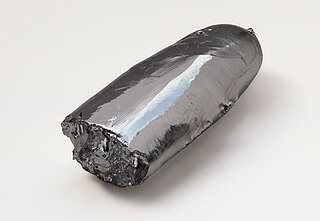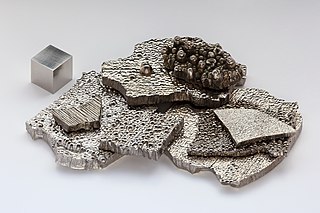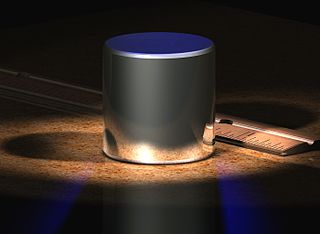
Osmium is a chemical element with symbol Os and atomic number 76. It is a hard, brittle, bluish-white transition metal in the platinum group that is found as a trace element in alloys, mostly in platinum ores. Osmium is the densest naturally occurring element, with an experimentally measured density of 22.59 g/cm3. Manufacturers use its alloys with platinum, iridium, and other platinum-group metals to make fountain pen nib tipping, electrical contacts, and in other applications that require extreme durability and hardness. The element's abundance in the Earth's crust is among the rarest.

Ruthenium is a chemical element with symbol Ru and atomic number 44. It is a rare transition metal belonging to the platinum group of the periodic table. Like the other metals of the platinum group, ruthenium is inert to most other chemicals. Russian-born scientist of Baltic-German ancestry Karl Ernst Claus discovered the element in 1844 at Kazan State University and named it after the Latin name of his homeland, Ruthenia. Ruthenium is usually found as a minor component of platinum ores; the annual production has risen from about 19 tonnes in 2009 to some 35.5 tonnes in 2017. Most ruthenium produced is used in wear-resistant electrical contacts and thick-film resistors. A minor application for ruthenium is in platinum alloys and as a chemistry catalyst. A new application of ruthenium is as the capping layer for extreme ultraviolet photomasks. Ruthenium is generally found in ores with the other platinum group metals in the Ural Mountains and in North and South America. Small but commercially important quantities are also found in pentlandite extracted from Sudbury, Ontario and in pyroxenite deposits in South Africa.

A pen is a writing instrument used to apply ink to a surface, usually paper, for writing or drawing. Historically, reed pens, quill pens, and dip pens were used, with a nib dipped in ink. Ruling pens allow precise adjustment of line width, and still find a few specialized uses, but technical pens such as the Rapidograph are more commonly used. Modern types include ballpoint, rollerball, fountain and felt or ceramic tip pens.

A precious metal is a rare, naturally occurring metallic chemical element of high economic value. Chemically, the precious metals tend to be less reactive than most elements. They are usually ductile and have a high lustre. Historically, precious metals were important as currency but are now regarded mainly as investment and industrial commodities. Gold, silver, platinum, and palladium each have an ISO 4217 currency code.
A period 6 element is one of the chemical elements in the sixth row (or period) of the periodic table of the elements, including the lanthanides. The periodic table is laid out in rows to illustrate recurring (periodic) trends in the chemical behaviour of the elements as their atomic number increases: a new row is begun when chemical behaviour begins to repeat, meaning that elements with similar behaviour fall into the same vertical columns. The sixth period contains 32 elements, tied for the most with period 7, beginning with caesium and ending with radon. Lead is currently the last stable element; all subsequent elements are radioactive. For bismuth, however, its only primordial isotope, 209Bi, has a half-life of more than 1019 years, over a billion times longer than the current age of the universe. As a rule, period 6 elements fill their 6s shells first, then their 4f, 5d, and 6p shells, in that order; however, there are exceptions, such as gold.

A dip pen or nib pen usually consists of a metal nib with capillary channels like those of fountain-pen nibs, mounted in a handle or holder, often made of wood. Other materials can be used for the holder, including bone, metal, and plastic; some pens are made entirely of glass. Generally, dip pens have no ink reservoir, so the user must recharge the ink from an ink bowl or bottle to continue drawing or writing. There are simple, tiny tubular reservoirs that illustrators sometimes clip onto dip pens, which allow drawing for several minutes without recharging the nib. Recharging can be done by dipping into an inkwell, but it is also possible to charge the pen with an eyedropper, a syringe, or a brush, which gives more control over the amount of ink applied. Thus, "dip pens" are not necessarily dipped; many illustrators call them "nib pens".

Group 9 is a group (column) of chemical elements in the periodic table. Members are cobalt (Co), rhodium (Rh), iridium (Ir) and meitnerium (Mt). These are all transition metals in the d-block.
Osmiridium and iridosmine are natural alloys of the elements osmium and iridium, with traces of other platinum-group metals.

A native metal is any metal that is found pure in its metallic form in nature. Metals that can be found as native deposits singly or in alloys include aluminium, antimony, arsenic, bismuth, cadmium, chromium, cobalt, indium, iron, manganese, molybdenum, nickel, niobium, rhenium, selenium, tantalum, tellurium, tin, titanium, tungsten, vanadium, and zinc, as well as two groups of metals: the gold group, and the platinum group. The gold group consists of gold, copper, lead, aluminium, mercury, and silver. The platinum group consists of platinum, iridium, osmium, palladium, rhodium, and ruthenium. Amongst the alloys found in native state have been brass, bronze, pewter, German silver, osmiridium, electrum, white gold, and silver-mercury and gold-mercury amalgam.
A microelectrode is an electrode used in electrophysiology either for recording neural signals or for the electrical stimulation of nervous tissue. Pulled glass pipettes with tip diameters of 0.5 μm or less are usually filled with 3 molar potassium chloride solution as the electrical conductor. When the tip penetrates a cell membrane the lipids in the membrane seal onto the glass, providing an excellent electrical connection between the tip and the interior of the cell, which is apparent because the microelectrode becomes electrically negative compared to the extracellular solution. There are also microelectrodes made with insulated metal wires, made from inert metals with high Young modulus such as tungsten, stainless steel, or Platinum-iridium alloy and coated with glass or polymer insulator with exposed conductive tips. These are most used for recording from the external side of the cell membrane, More recent advances in lithography have produced silicon based microelectrodes.
John Holland was a prominent American businessman and industrialist whose "John Holland Gold Pen Company" was a large maker of pens and related products during the late 19th century. In his business activities, he made several metallurgical and mechanical advancements, the most notable being a process for creating stable bars and other usable forms of iridium.

Esterbrook is a brand of Luxury fountain, ballpoint and roller Ball pens. The brand was revived by Harpen Brand Holdings, LLC, which acquired the rights to manufacture pens under the "Esterbrook" brand name in 2014. In 2018, The Esterbrook Pen brand was acquired by Kenro Industries, Inc based in Mineola New York.
Graf von Faber-Castell is a line of fine writing instruments from the German stationery manufacturer Faber-Castell. It includes a line of pencils, mechanical pencils, fountain pens, and rollerball pens. Currently, Graf von Faber-Castell makes high end writing instruments made with luxury materials such as ebony, resin, and ivory.

Platinum-iridium alloys are alloys of the platinum group precious metals platinum and iridium.












